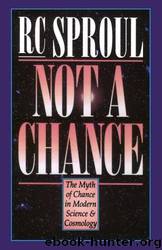Not a Chance: The Myth of Chance in Modern Science and Cosmology by R. C. Sproul

Author:R. C. Sproul
Language: eng
Format: mobi
Tags: Non-Fiction, Science
ISBN: 9780801058523
Published: 1994-09-01T04:00:00+00:00
The problem of the relationship between the essence of a thing (Ding-en-sich) and its accidens or qualities has been the source of endless controversy in the church. The Roman Catholic doctrine of transubstantiation has been the focal point of the debate. Though cloaked in Aristotelian terminology, the church breaks sharply at one crucial point with the philosopher.
The formula for transubstantiation is this: In the miracle of the Mass the substance of bread and wine changes (trans-, moves “across”) into the substance of the body and blood of Christ, but the accidens of bread and of wine remains the same.
As a result of this miraculous change we have the substance of one thing present without its corresponding accidens, and the accidens of another thing without its corresponding substance. We have the substance of Christ’s body and blood and the accidens of bread and wine.
Martin Luther protested against this because it involves two miracles, which he thought was a frivolous and unnecessary philosophizing of the Mass. Two miracles are required: one to have the substance of a thing present without its accidens, and another to have the accidens present without its substance.
The idea of a miracle is introduced here to “save the phenomena” and to account for the departure from Aristotle’s view that substance and accidens are immutably joined together. What Aristotle joined together, the church rent asunder.
The phenomena had to be “saved” because, before the miracle takes place in the Mass, the common elements of bread and wine still have the accidens of bread and wine. They are clearly perceived as bread and wine. They look like bread and wine, taste like bread and wine, smell like bread and wine, and feel like bread and wine. If we dropped them, they would sound like bread and wine.
After the miracle of transubstantiation there is a change in reality but not in perception. It is an unperceived transformation. The essence may change but the phenomena remain the same. The elements still taste like bread and wine, look like bread and wine, and so forth.
There are other theological issues that make transubstantiation problematic. Our concern at this point, however, is not primarily theological but epistemological and ontological. That Rome sees a miracle as special supernatural work necessary for transubstantiation indicates a tacit commitment to a view of nature or science that sees a natural and real link between substance and accidens.
We may define accidens or primary qualities as the external manifestation of substance. It is more than representation, as in the case of a painting or a word. The primary qualities are themselves an integral part of reality.
If that is so, then when we are in touch with the phenomena, we are in touch, at least “accidentally,” with reality. There may be a deeper or hidden dimension to the reality that remains unperceived, but this does not warrant the inference that there is no reality underlying the phenomena.
In traditional physics the link between essence and phenomena was assumed to be a causal one. This is why the question of causality burns so intensely in the contemporary debate.
Download
This site does not store any files on its server. We only index and link to content provided by other sites. Please contact the content providers to delete copyright contents if any and email us, we'll remove relevant links or contents immediately.
| Aeronautics & Astronautics | Astronomy |
| Astrophysics & Space Science | Comets, Meteors & Asteroids |
| Cosmology | Mars |
| Solar System | Star-Gazing |
| Telescopes | UFOs |
Tools of Titans by Timothy Ferriss(8304)
Turbulence by E. J. Noyes(7977)
Secrets of Antigravity Propulsion: Tesla, UFOs, and Classified Aerospace Technology by Ph.D. Paul A. Laviolette(5332)
Astrophysics for People in a Hurry by Neil DeGrasse Tyson(5151)
Room 212 by Kate Stewart(5070)
Design of Trajectory Optimization Approach for Space Maneuver Vehicle Skip Entry Problems by Runqi Chai & Al Savvaris & Antonios Tsourdos & Senchun Chai(5037)
Pale Blue Dot by Carl Sagan(4953)
The David Icke Guide to the Global Conspiracy (and how to end it) by David Icke(4656)
A Journey Through Divination and Astronomy by Publishing Pottermore(4363)
Goodbye Paradise(3761)
Apollo 8 by Jeffrey Kluger(3667)
COSMOS by Carl Sagan(3588)
The Five People You Meet in Heaven by Mitch Albom(3520)
Losing the Nobel Prize by Brian Keating(3518)
How to Read Water: Clues and Patterns from Puddles to the Sea (Natural Navigation) by Tristan Gooley(3431)
Brief Answers to the Big Questions by Stephen Hawking(3392)
How to Read Nature by Tristan Gooley(3290)
The Order of Time by Carlo Rovelli(3162)
A Brief History of Time by Stephen Hawking(2991)
